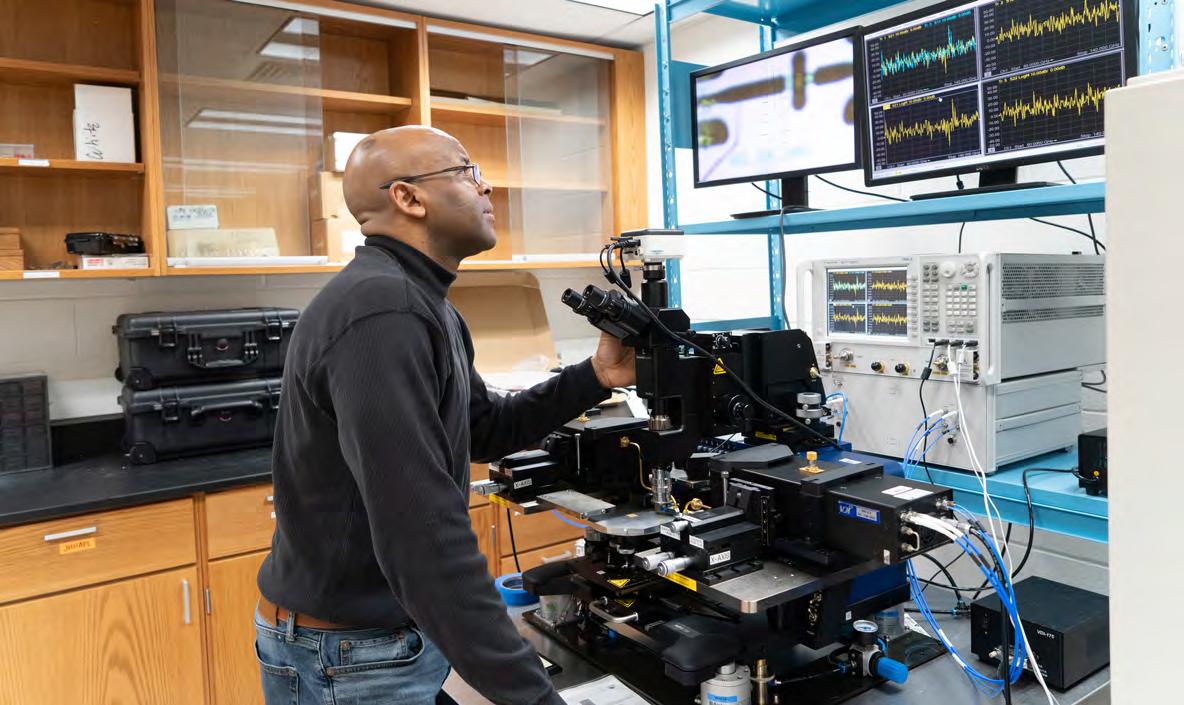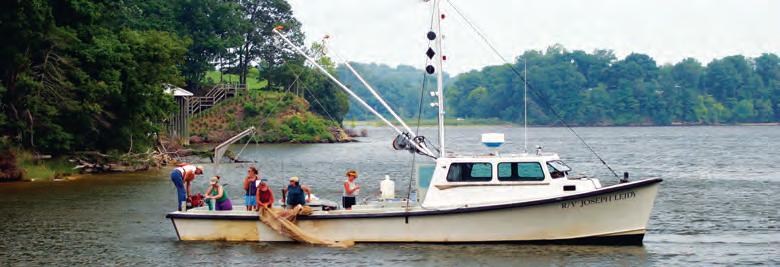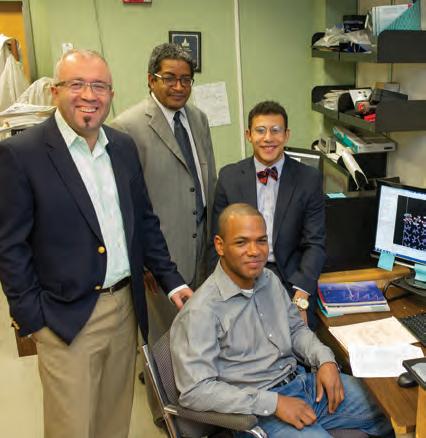
9 minute read
Research and Innovation
Alaw passed by the Maryland General Assembly and signed by Maryland Gov. Larry Hogan in May 2017 designated Morgan State University as the state’s Preeminent Public Urban Research University. MSU’s accomplishments over the previous seven years had proven the designation well-earned. After decades of foundational work, transformative research achievements came in quick succession beginning in 2010, when the University gained a $3.1-million share of a $129-million U.S. Department of Energy grant to Penn State University to research energy innovation. Another major milestone was reached in 2011, when MSU procured its largest research contract to date: a $28.5-million, five-year agreement with NASA in a program titled GESTAR, Goddard Earth Sciences Technology and Research. Two years later, the University established its Division of Research and Economic Development (D-RED), which has primary responsibility for research policy, oversight of the administration and management of grants and contracts to support faculty research activity, and oversight of responsible conduct of research education and compliance at Morgan. D-RED works with the University’s deans and department chairs to develop and support institutional and crossdisciplinary research initiatives and serves as the initial point of contact for organizations interested in connecting with the MSU research enterprise to explore possible collaborations. The organizational change that created D-RED has yielded tremendous benefits, as the division — and its previous incarnations — has overseen more than $314 million in awarded contracts and grants. Among the many highlights: in 2014, Morgan received a $23.3-million award from the National Institutes of Health (NIH) to launch “AStudentCentered, Entrepreneurship Development” (ASCEND) Training Model to Increase Diversity in the Biomedical Research Workforce.” The competitive award was the second-largest in the University’s history and the highest to date to Morgan from the NIH. Additional wins increased Morgan’s momentum in research in 2019: to list just a few, the NIH continued its support of ASCEND with $16.9 million in additional funding; NASA and USRA, Morgan’s lead partner in GESTAR, extended the University’s participation in that program for an additional five years, increasing the value of the contract to $40 million; and a fiveyear grant from the Silicon Valley-based financial technology (“fintech”) firm Ripple funded an academic partnership to advance research, technical development and innovation at MSU in blockchain, cryptocurrency and digital payments.
In December 2018, the Carnegie Classification of Institutions of Higher Education moved Morgan to an elevated classification of R2, a status reserved for doctoral universities with high research activity. The University joined only 130 other institutions nationwide — including fewer than a dozen HBCUs — that have an R2 classification. The elevation by Carnegie came as a result of a long, concerted effort of Morgan faculty and staff to increase the number of qualified graduates of the University and expand the types of research conducted on campus as well as in the community. Morgan faculty research spans all academic disciplines, from child welfare to cybersecurity, from music composition to sustainable development. The University’s research programs have inspired thought leaders, scientists and students and serve as a catalyst for economic growth in Baltimore and in the state of Maryland. Statistics show that Morgan generates significantly more key innovation outputs and outcomes per research dollar than state and national averages. Thus, dollars invested in Morgan go further in producing innovations such as invention disclosures and start-up companies, specifically innovation that directly benefits the state, its population and its natural resources.
Morgan’s focus on innovation has also enhanced the University’s campus operations, in areas ranging from course delivery to facilities construction to digital communication. n


Carnegie Classification of Institutions of Higher
Education R2 Doctoral Universities – High Research Activity

Innovation at Morgan, by the Numbers
108
Intellectual Property Disclosures have been submitted to Morgan from FY 2011 through FY 2020 (only 1 before FY 2011)
25 19
U.S. Utility Patent Applications have been submitted by Morgan to the U.S. Patent and Trademark Office; 7 U.S. Patents issued
Patents Pending (all since FY 2012)
6
Start-up companies have been formed by local entrepreneurs based on Morgan innovations

Innovation Metrics, per $10 Million in Research Expenditures
START-UPS FORMED
NEW PATENT APPLICATIONS
0.16 0.14 1.27
2.21 1.37
LICENSES
1.18 0.59 1.27 7.64


INVENTION DISCLOSURES
3.84 2.9
14.1
0 2 4 6 8 10 12 14 16
National Research Universities State of Maryland Research Universities Morgan State University
U.S. Patents Awarded to Morgan Faculty, Staff and Students
Note: All patents have been issued since 2016. Serial Number U.S. Patent 10,673,469 Title Multi-band multi-mode software defined radio
U.S. Patent 10,626,363
U.S. Patent 10,333,620
U.S. Patent 10,253,974 U.S. Patent 9,973,275 U.S. Patent 9,243,017 Engineered cyanobacteria with enhanced salt tolerance System and method for lighting and building occupant tracking System and method for biomass combustion Lighting and building occupant tracking Metal-assisted and microwave-accelerated evaporative crystallization Portable shellfish basket washer Inventors Willie Thompson; Samuel Berhanu; Jan-Paul Alleyne Viji Sitther; Behnam Tabatabai
Kofi Nyarko; Christian Emiyah; Samuel Mbugua
Seong Lee Kofi Nyarko; Christian Emiyah; Samuel Mbugua Kadir Aslan


Morgan Innovation Start-up Companies, 2010–2020 Start-up Companies Formed by Local Entrepreneurs, Based on Morgan Innovations
Company STEAM Abroad, Inc. The Literacy Rescue, LLC Morgan Innovation Description Global Competency Study Abroad Platform Adaptive Intelligence to Improve Literacy
HaloCyTech, LLC * SVE Technologies, LLC CykloBurn Technologies, LLC * iCrystal, LLC
*License agreement established Cyanobacteria BioProducts Toroidal Combustion Chamber Ultra-Clean Biomass Combustor Microwave-Accelerated Crystallization

Morgan Innovator(s) Kimberly Warren Kimberly Reaves; LeeRoy Bronner; Kofi Nyarko Viji Sitther; Behnam Tabatabai Arthur Willoughby Seong Lee Kadir Aslan

D-RED’s Leadership In December 2012, Morgan State University President David K. Wilson announced the selection of Victor R. McCrary, Ph.D., to fill the University’s newly created position of vice president for research and economic development. The unit Dr. McCrary was selected to lead, Morgan’s Division of Research and Economic Development (D-RED), was formally established in 2013.
With Dr. McCrary’s departure from Morgan to join the University of Tennessee, Knoxville in 2018, the University selected Willie E. May, Ph.D., to lead D-RED. Dr. May came to Morgan from the University of Maryland, College Park, where he was director of major research and training initiatives for the College of Computer, Mathematical, and Natural Sciences. Immediately before taking that post, he served as the Senateconfirmed U.S. undersecretary of commerce for standards and technology and director of the National Institute of Standards and Technology (NIST), capping a 45-year career at that institution. Under his leadership, Morgan’s research and innovation outputs have continued their upward trajectory.
Over the past 10 years, D-RED (previously Research Administration, Sponsored Programs) has overseen more than $314 million in awarded contracts and grants.

Morgan Innovation Day Morgan State University’s Division of Research and Economic Development (D-RED) and MSU’s Office of Technology Transfer hosted the 10th Annual Morgan Innovation Day in February 2020, at the Miller Senate Office Building in Annapolis, Maryland. The event, launched during the first year of MSU President David K. Wilson’s tenure, serves in part as a progress report on Maryland’s Preeminent Public Urban Research University and the beneficial social and economic impact of its work on the state and the region. Morgan Innovation Day has given opportunities to Morgan faculty, students and staff to showcase hundreds of research projects and innovations for state and local legislators and other government officials since 2011. First Technology Transfer Agreement Technology developed by Seong Lee, Ph.D., and his research staff in the Center for Advanced Energy Systems and Environmental Control Technologies (CAESECT) in Morgan’s Clarence M. Mitchell Jr. School of Engineering led to the execution of Morgan’s first-ever technology licensing contract in 2018. “Method and Design of the Ultra-Clean Mobile Combustor for Waste Biomass and Poultry Litter Disposal,” commonly referred to as CycloBurn, is being commercialized by Cykloburn Technologies, LLC, a company formed by two Maryland entrepreneurs. The technology addresses two significant societal needs: managing environmentally damaging pollution from excess poultry farm litter and generating energy — both electricity and heat — from renewable resources. The technology represents a significant value proposition to individual poultry farmers, by ridding them of poultry waste, creating electricity for operations and providing heat for poultry houses.

Annual Innovation Awards A building occupant tracking system, a bio-product production method, a diabetic shoe and custom insole, and a perceived risk methodology were among the “Morgan Made” scientific and technological advancements and solutions honored at MSU’s Second Annual Innovation of the Year Awards, in December 2019. Created by the Office of Technology Transfer of the University’s Division of Research and Economic Development (D-RED) , the awards aim to celebrate campuswide innovation and recognize the contributions of the Morgan community and University advancement through discovery, invention and development.
Grant Funding Expands Research at PEARL Morgan’s Patuxent Environmental and the National Oceanic and Atmospheric Aquatic Research Laboratory (PEARL) Administration, National Sea Grant and secured nearly a half-million dollars the Maryland Department of Natural in research grants in 2019 to advance Resources. The funds are providing the vitality and sustainability of the critical resources to support specific Chesapeake Bay and its tributaries. The programs and active research PEARL grants, totaling $471,000, were awarded is now spearheading or supporting in by the U.S. Fish and Wildlife Service, consortia.




PEARL, located in St. Leonard, Maryland, became part of the University in 2004. Its mission is “to provide society with the knowledge to solve its environmental challenges through research, education and economic development.”





MSU Centers, Institutes and Initiatives The Center for Cybersecurity Assurance and Policy (CAP) Patuxent Environmental and Aquatic Research
Laboratory (PEARL) Center for Global Studies and International
Education (CGSIE) Center for Signal and Sensor Processing (SIGSENS) Center for Advanced Energy Systems and
Environmental Control Technologies (CAESECT) Center of Excellence in Tactical and Advanced
Communication Technologies (CETACT) Center of Microwave /Satellite and Radio
Frequency Engineering (COMSARE) Engineering Visualization and Research
Laboratory (EVRL) Center for Biomedical Research (ASCEND) Center for Sexual Health Advancement and
Prevention Education (SHAPE) Center for Excellence in Mathematics and Science
Education (CEMSE) Urban Mobility and Equity Center (UMEC) National Transportation Center (NTC) Network Information and Embedded Systems
Security Center of Academic Excellence (NIESS-CAE)










